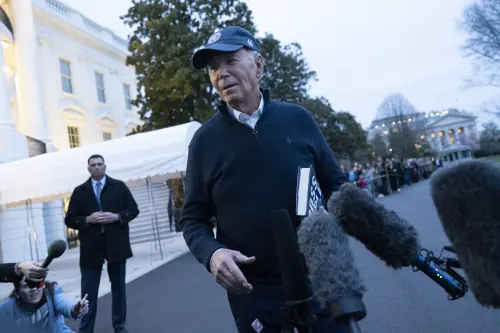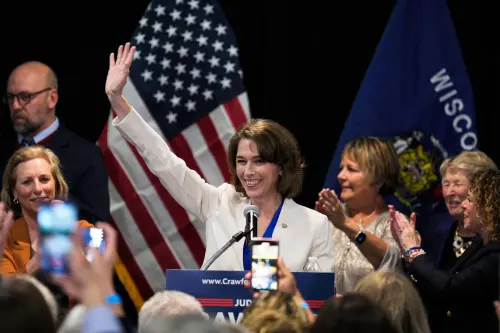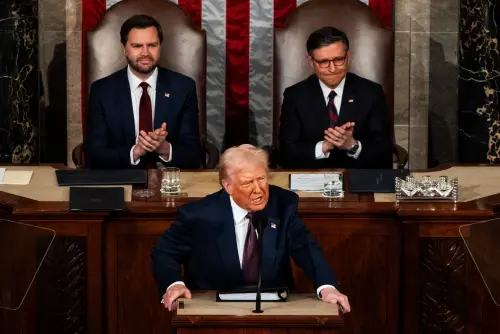In a fighting State of the Union address, much of which could have been delivered at a campaign rally, President Joe Biden directly criticized his predecessor more than a dozen times and drew lines that he hopes will define the 2024 presidential election. He was an unabashed liberal on social policy, a populist nationalist on economic policy, and a traditional postwar internationalist on foreign policy.
Biden’s forceful delivery was meant to signal that he is not too old to serve out a second term, which most Americans currently think he is. Indeed, projecting vigor and strength was one of the main objectives of the evening. Gone was his tendency to speak in a near whisper; through much of the speech he practically shouted. He ended his speech with an argument that his age is an advantage—that through extended experience, he has learned what he needs to lead the country in challenging times.
“The state of the union is strong and getting stronger,” President Biden declared. He may well have had no choice. The fact remains that the American people don’t agree with him. In a new CBS poll, 61% of Americans described the state of the country as “divided,” 45% as “declining,” 37% as “weak,” and just 15% as “strong.” Tellingly, only 25% of Democrats saw the state of the country as strong. Biden clearly hopes that he began to change their minds and that subsequent events will vindicate his optimism in time for the election. It remains to be seen whether his decision to lean against public sentiment will reduce his credibility and make him look out of touch.
To the surprise of few, the defense of democracy against autocracy at home and abroad was a central theme of the speech, which depicted Donald Trump as a threat to both. To the surprise of many, Biden led off the speech with an impassioned defense of the need to aid Ukraine and stop Vladimir Putin from conquering Ukraine and threatening all of Europe. Quoting Trump’s own words, he accused him of bowing down to Putin and moved on to accuse his predecessor of trying to “bury the truth of January 6th.”
Biden’s defense of his economic record was lengthy and detailed, with references to massive job creation, sustained low unemployment, small business creation, a manufacturing revival, and a shrinking racial wealth gap. He appealed directly to workers without college degrees, touting his enforcement of long-neglected “Buy American” laws and massive investment in infrastructure projects. He noted the recent surge in consumer confidence and must hope that a continued shift in the public mood about the economy will help him move from defense to offense on this critical issue. It remains to be seen whether his attack on drug companies and other corporations for alleged price-gouging will help him defuse the issue of high prices, the public’s main complaint about his economic record. And while the lengthy list was impressive, it fell short of being the sort of concise narrative that could be easily understood on the campaign trail.
The case was very different when it came to freedom of choice, where there were no such ambiguities. He condemned Donald Trump and his supporters for overturning Roe v. Wade and called for national legislation to restore Roe as the law of the land. In a similar vein, he criticized the move, which started in Alabama, to interfere with access to in vitro fertilization, many couples’ only chance to have biological children, and he called for national legislation to secure access to IVF nationwide. In this context and others, he invoked the political power of women and urged them to use this power to defend their freedom.
Turning to plans for a second term, Biden presented a lengthy laundry list of liberal proposals on health care, education, housing, and taxes. Most were aimed at the high prices middle-class Americans face that prevent them from giving Biden credit on the economy. While these measures may help fire up the base, they may not appeal to undecided swing voters, let alone the Haley voters whom the president invited to join his coalition just days ago.
Still, the president did better on offense than with the issues that have put him on the defensive. On immigration, he ignored advice from some Democrats to shut the border immediately and contented himself with calling on Congress to pass the bipartisan border bill that Senate Republicans abandoned under pressure from former president Trump. Similarly, he did not go beyond traditional Democratic proposals for fighting violent crime and missed an opportunity to break new ground on the fight against the epidemic of fentanyl and other deadly opioids.
He was more innovative about Hamas’ murderous attack on Israel and the situation in Gaza, which have already cost many thousands of civilian lives. He insisted that Israel has a responsibility to minimize civilian casualties, even as they pursue a ruthless enemy that uses human shields as a cornerstone of its military strategy. He also cited an urgent need to get food and other humanitarian aid to desperate Gazans and ordered the construction of a temporary port in the sea that would permit American vessels to get this aid where it is needed without, the president promised, putting American boots on the ground. He reiterated his support for a temporary ceasefire and an eventual two-state solution, which he characterized as the only path to durable peace between Israel and its neighbors in the region. Not until November will we find out whether these initiatives will be enough to soothe the anger of Arab and Muslim Americans whose defection threatens the president’s hold on the vital swing state of Michigan.
During his speech, President Biden referred with approval to two past presidents, Franklin Roosevelt and Ronald Reagan. But it was the spirit of Harry Truman’s 1948 campaign that suffused everything he said and how he said it. Biden and his advisors have signaled that they regard blunt, no-holds-barred partisanship as the best path to victory against Donald Trump, whom he trails in most polls. In a time of intense polarization, they believe, mobilizing the base is Job One. The president talked optimistically about America’s comeback, but the speech was intended to promote his own comeback as well.
The Brookings Institution is committed to quality, independence, and impact.
We are supported by a diverse array of funders. In line with our values and policies, each Brookings publication represents the sole views of its author(s).








Commentary
The State of the Union: Biden fights back
March 8, 2024